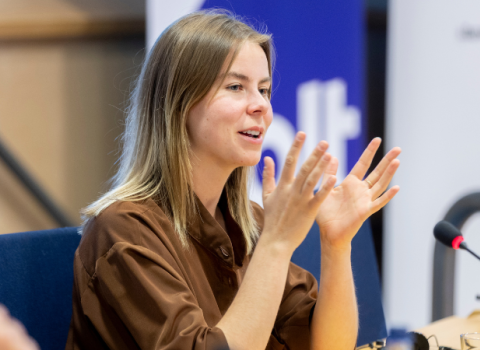
Intercell’s Alexander von Gabain: rewriting the start-up rule book.
The team included Max Birnstiel, a senior scientific statesman and outgoing scientific director of the Institute of Molecular Pathology (IMP) in the Vienna Biocenter research campus; von Gabain, a globetrotting professor of microbiology at the University of Vienna, with stints at Heidelberg University, Stanford University and the Karolinska Institute in Stockholm already under his belt; Michael Buschle and Walter Schmidt, scientists who were still in the early stages of their careers; and Aaron Hirsh, then a pony-tailed young student, who later found fame as a respected science writer.
With von Gabain at the helm, this group laid the foundations of an enterprise that would rise to the top of Europe’s biotechnology pile over the next decade and, arguably, rewrite the region’s rules for biotechnology start-ups.
More than any other company, Intercell has firmly debunked the notion that location is a determinant of success in biotechnology. While the majority of Europe's most prominent firms is clustered in the UK, Germany, Switzerland, France, Denmark and Sweden, each of which has a longstanding tradition in pharma research and a supportive capital market, Intercell has shown that neither is strictly necessary.
Operating from Vienna, Austria, a region never previously considered a major international life sciences hub, and quoted on the Vienna Stock Exchange – a market with no prior history of biotechnology investing – Intercell has built a market capitalisation of around a billion euros and has gained a reputation as Europe’s foremost vaccines innovator.
“It does seem as though the borders have broken down,” says Peter Welford, analyst at Lehman Brothers in London. “They’ve demonstrated that you don’t need to have strong local [investor] support for your industry.”
Broad base of backers
Instead, the company has managed to win over a broad base of international backers, attracted by the quality of the company and by its ability to consistently crank out significant deals with the vaccine industry’s biggest players, among them Merck, Sanofi-Aventis, Wyeth and Novartis.
Its multi-faceted alliance with Novartis, signed in July, will doubtless rank among the largest transactions in European biotech this year. With €270 million in guaranteed cash, and hundreds of millions more in potential milestones, it will also transform Intercell’s balance sheet and give it the kind of financial strength and flexibility enjoyed by just a handful of Europe’s biotechnology elite.
Those who invested in the company’s IPO in February 2005 have been amply rewarded. Its shares, initially priced at €5.50 each, peaked at €29.77 during July, and were changing hands at around €27 in early December, amid the turmoil in the global markets.
Much of the company's success can be attributed to von Gabain, who is widely credited not only for his scientific capability, but also for his commercial nous and distinct lack of ego.
“He recognised what he did know, but he also recognised what he didn’t know and needed to bring on board,” says Cathrin Petty, healthcare partner at Apax Partners in London, which led Intercell’s €27 million Series B round in January 2001. “He was responsible for recruiting a stellar team.”
Von Gabain handed over the CEO job to the company’s erstwhile chief operating officer Gerd Zettlmeissl, who has a pharma industry background, in October 2005 and took on the role of chief scientific officer himself.
Recipe for success
Von Gabain himself attributes Intercell's success to three principal factors: a strong scientific platform; a strong team; and the ability to “be humble and never promise more than you can deliver”. Too many young biotechnology firms, particularly in Europe, are starting out without a “really innovative and robust founding technology”, he says, unlike the first generation of industry leaders, such as Genentech, Biogen Idec and Genzyme.
“The science coming out of the IMP was incredibly strong,” says Petty. At its core was the Antigen Identification Program, an approach that enables Intercell to systematically screen the entire proteome of bacterial pathogens against an array of antibodies isolated from individuals who have successfully countered infections from the same species.
This technology allows Intercell to pick out bacterial epitopes or molecular motifs that can form the basis of novel vaccines or novel monoclonal antibodies. The company also has immune-boosting adjuvant technologies, a peptide vaccine platform, and it demonstrated its clinical development and manufacturing capabilities by in-licensing a vaccine against Japanese Encephalitis Virus, which is expected to gain FDA approval next year.
The team von Gabain built was strongly multinational from the start, with over a dozen nationalities represented during the company’s early stages of development. That kind of mix, von Gabain says, is essential for developing a broad, flexible approach to problem solving and to accommodating alternative points of view.
In a monocultural environment, von Gabain says, people become obsessed by the need to conform to their cultural norms. He also attracted tier-one venture capital investors – among them TVM, its first-round investor, and Nomura International, as well as Apax, and a weighty scientific advisory board, which included his old postdoctoral supervisor, the Stanford-based genetic engineering pioneer Stanley N. Cohen. “We were really striving for quality from day one.”
The Novartis deal is opening up a new chapter in the company’s existence. Peter Welford speculates that the alliance could evolve into the fabled relationship that exists between Genentech and Roche.
Novartis, which will own 16 per cent of Intercell when the deal closes, is not taking a seat on its board and has emphasised that it wants Intercell to maintain its innovative culture. Some of that innovative thinking will have to be brought to bear on what to do with a cash pile of more than €300 million. “The world is almost expecting Intercell to do something,” von Gabain says.




 A unique international forum for public research organisations and companies to connect their external engagement with strategic interests around their R&D system.
A unique international forum for public research organisations and companies to connect their external engagement with strategic interests around their R&D system.